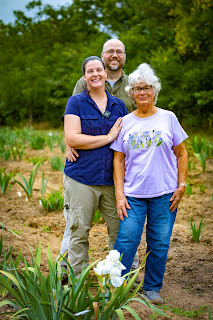by Heather Haley
In addition to being a member of the American Iris Society (AIS), I am an active participant and volunteer in North Carolina Cooperative Extension programs. I completed the NC Farm School program 2019. Earlier this month, my husband Chris and I hosted a farm visit for another Farm School graduate, her instructor, and a new horticulture extension agent in our county.
 |
| Heather's family with reblooming iris 'Mesmerizer' on their farm in Ramseur, North Carolina photo by Grace Kanoy, GeoCore Creative Inc. |
Winter is approaching quickly, and Chris and I spent that morning straightening up the kitchen -- just in case we needed to move farm conversations inside. When the visitors arrived, they were met with spring-like conditions and all enthusiastically wanted to visit the production field for bearded irises. The intent of this visit was to support a beginning nursery owner, discuss interests, and share experiences in the business of horticulture. However, once visitors realized the farm had several irises blooming in mid-November, they lost all thought of business pursuits and became highly inquisitive about these plants.
One inquired, "Are the irises CONFUSED?" I laughed gently and replied, "No. Those are rebloomers. They are just doing what they do best."
Chris and I explained that each of the various irises on our property has genetic information coded in their DNA. Differences in DNA make each iris interesting and different from other varieties. Some iris genes control traits like flower color, whereas others can modify growth and reproductive cycles. With the right DNA sequence, an iris can shorten or skip summer dormancy and proceed directly into its next growth cycle. If climate and cultural conditions are just right, it is possible for daughter rhizomes to bloom in the same year as their mother. These irises aren't confused; they are just unusually prolific. Science buffs use the term "remontant" to describe plants that flower more than once in a growing season. "Rebloom" is the colloquial term for this phenomenon, and an entire chapter on it appears in the third AIS study of the genus Iris: a 1978 book titled The World Of Irises*.
*The World of Irises book is now out of print, but used copies can be found online. Wayne Messer and Bob Pries have also transcribed select book chapters (including Raymond Smith's chapter on Rebloom) for Iris Encyclopedia. AIS is always looking for volunteers who can type existing content into this online library. If you are interested and available for transcription projects like this, please reach out to Bob at bobpries3@gmail.com.
Chris reminisced about our household's earliest experience with a reblooming iris. After spending years in apartments during our college years, Chris and I became first-time homeowners and took to gardening in earnest. A modest collection of 19 irises arrived in September 2012 and were gifts from my mother Alleah. We planted them on the north side of the house where they would have good drainage and receive plenty of sun. Among these irises was 'Peggy Sue.' Alleah's description of this iris was deceptively plain: Peggy Sue - L. Lauer '06 - pink, red beard, lightly ruffled. Although we didn't know it then, 'Peggy Sue' was destined to confuse and delight us.
Several of our new irises bloomed the following spring, but 'Peggy Sue' wasn't among them. Her first bloomstalk appeared much later . . . in NOVEMBER! We were ecstatic to enjoy a flower in bloom, but also wrongly assumed this iris was confused. I posted a garden photo on Facebook, and included it in an e-mail to other members of the family.
 |
| Fall 2013 |
 |
| Spring 2014 |
After planting some extra rhizomes of 'Peggy Sue' in the backyard, it became obvious that 'Peggy Sue' in the front yard had better growing conditions. These conditions led to more consistent bloom and rebloom in the front yard compared to the back. Rebloomers appreciate being watered throughout the summer. Frequent rain combined with a leaky hose spigot provided front yard 'Peggy Sue' regular access to water when she wanted it. She responded by blooming regularly and making lots of increases.
 |
| Fall 2014 |
 |
| Early Spring 2015 |
 |
| Very Early Spring 2016 |
 |
| Winter 2015 |
 |
| Late Winter 2017 |
 |
| 'Bonus Mama', Early Fall 2018 |
 |
| This must-have resource is available as a printed book, flash drive, and digital file sent by e-mail |










